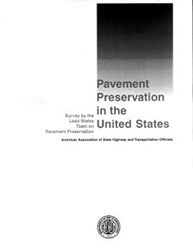U.S. Department of Transportation
Federal Highway Administration
1200 New Jersey Avenue, SE
Washington, DC 20590
202-366-4000
Focus
| Accelerating Infrastructure Innovations |
Publication Number: FHWA-RD-00-063
Date: November 2000
The seven American Association of State Highway and Transportation Officials (AASHTO) Lead States teams "set a model for technology deployment that will be used for years to come," says John Conrad of the Washington State Department of Transportation and chair of the AASHTO Task Force on SHRP Implementation. That model was both celebrated and reflected upon at the fifth and final Lead States Workshop, held in St. Louis in September. The workshop was the culmination of four years of work by the teams, with their term of service now ending and responsibility for the implementation of the SHRP technologies being handed over to various AASHTO subcommittees.
Those four years of work have seen the creation of videotapes, brochures, and Web sites; the development of instructional workshops; the writing of handbooks and guide specifications; and the fielding of countless phone calls and emails from State and local highway agencies, all with the end goal of taking the new SHRP technologies and making them mainstream. These activities fulfilled the promise put forth by William Burnett, the then chairman of the Task Force on SHRP Implementation, in 1995: "By sharing their experiences with others, Lead States can help other States implement products more easily." All told, more than 100 representatives from 23 State highway agencies, industry, academia, and the Federal Highway Administration (FHWA) took part in the shared effort. "The Lead State initiative," said John Horsley, Executiv Director of AASHTO, "is a success story unto itself."
At the meeting, team members gathered for the last time to both review their accomplishments and finalize their transition plans for shifting responsibilities to the AASHTO subcommittees. The accomplishments include:
Almost half of States are now using high-strength HPC in construction of bridge girders. Other States are beginning to use HPC for both superstructures and substructures.
But for the teams, just as important as their past efforts are the transition plans for what is to come. For the anti-icing/road weather information systems (RWIS) team, the transition plan includes continuation of a project looking at the documentation of the benefits and costs associated with anti-icing/RWIS technology, as well as a project to develop a formal training program for the technology. The pavement preservation team's transition goals include ensuring that industry and local governments stay involved in implementation efforts, promoting a linked pavement preservation/pavement management system strategy, and establishing a clearinghouse to enable the sharing of data between research groups and highway agencies. And the alkali-silica reactivity (ASR) team is urging that the follow-on work by AASHTO include developing methods that will rapidly and reliably evaluate the performance of concrete mixtures for ASR susceptibility. All of the teams, meanwhile, support the continuation of the Lead States Web site (leadstates.tamu.edu), which has been a vital resource for those looking for information and documents. "Communication is the key to continued success," said Dean Carlson, Secretary of Transportation for the State of Kansas.
Each of the team transition plans can be found on the Lead States Web site. For a list of the AASHTO subcommittees taking over team responsibilities, see below.
The Lead States teams won't be meeting again. But their success will continue to stretch beyond just the implementation of the SHRP technologies. As Byron Lord of FHWA noted at the close of the workshop, the teams have "changed the future and created a new paradigm of technology transfer. They leave a legacy of excellence."
 |
 |
|
The work of the Lead States teams included creating and distributing a variety of newsletters, reports and brochures on the SHRP technologies. |
AASHTO Subcommittee Contacts